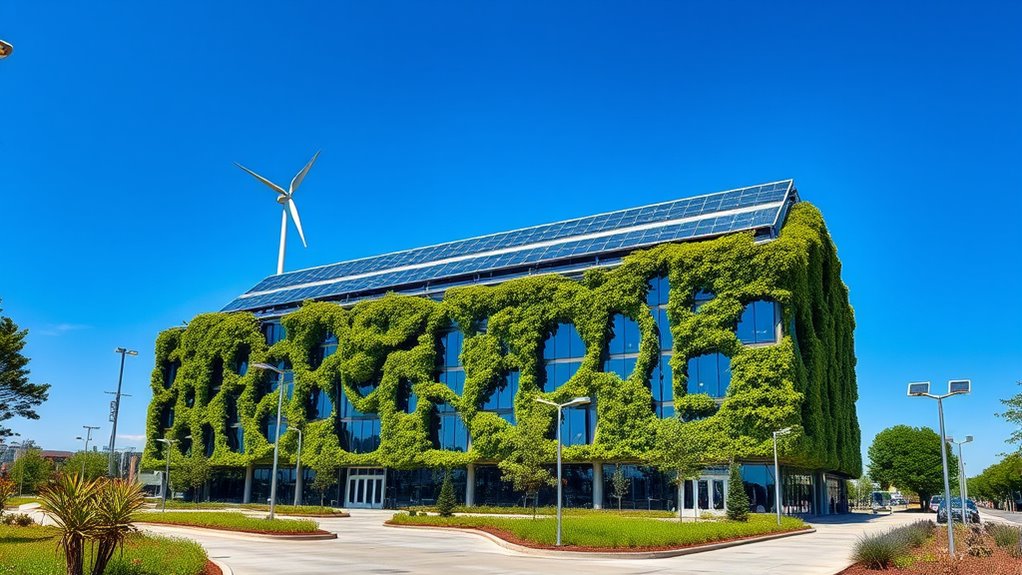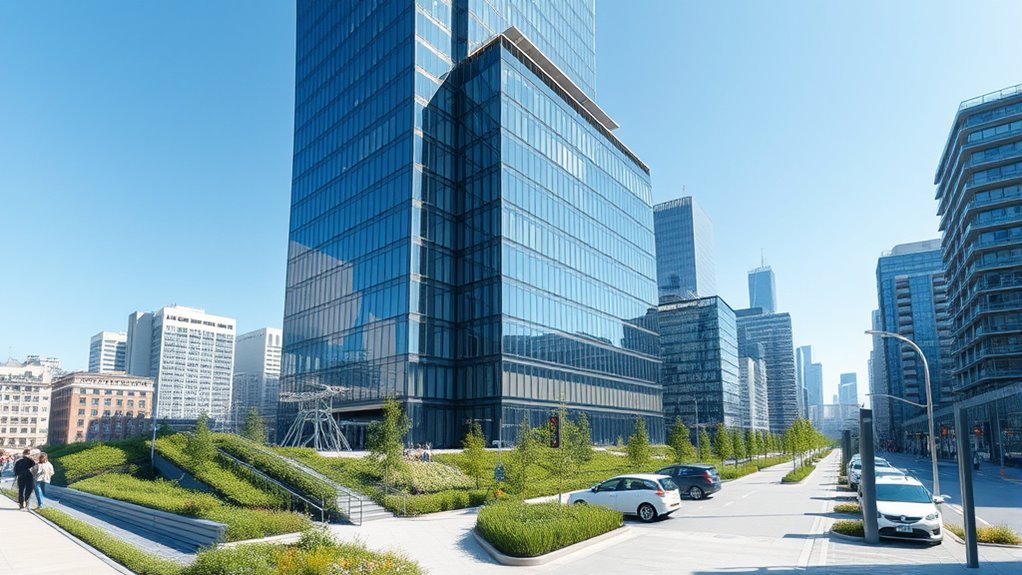Zero-emission building mandates are shaping the future of construction by requiring new buildings and major renovations to produce net-zero emissions through integrated renewable energy systems. These standards push you to contemplate sustainability early, incorporating renewable sources like solar and wind to minimize carbon footprints. As buildings are designed to generate their own clean power, they become more resilient and eco-friendly. Keep exploring how these mandates are transforming the industry and what the next steps could be.
Key Takeaways
- Building codes increasingly require renewable energy integration, making zero-emission buildings standard practice.
- Mandates drive early design considerations focused on local climate and renewable resource utilization.
- Construction practices are evolving to incorporate innovative materials and energy-efficient technologies.
- Zero-emission building policies promote sustainability, reduce long-term costs, and support climate targets.
- Future regulations will likely expand to include generating on-site clean energy, transforming the construction industry.

As cities and governments commit to combating climate change, zero‑emission building mandates have become a essential strategy. These mandates require new constructions and major renovations to produce zero net emissions, pushing the construction industry toward sustainability. To achieve this, building codes play a pivotal role by setting clear standards that promote energy efficiency, renewable energy integration, and reduced emissions. You’ll find that modern building codes increasingly mandate the use of renewable energy sources like solar panels, wind turbines, or geothermal systems. These codes aren’t just suggestions; they’re enforceable rules that guide construction practices, ensuring new buildings are designed to minimize their carbon footprint from the outset.
By adhering to these updated building codes, you’re encouraged to incorporate renewable energy solutions into your projects. This shift means designing buildings that can generate their own clean energy rather than relying solely on grid power, which often depends on fossil fuels. Installing solar panels on rooftops or integrating other renewable technologies becomes part of the standard process, aligning with the goal of zero emissions. Building codes are evolving to require these features, making renewable energy a fundamental component of new constructions. This not only helps cities meet their climate targets but also reduces long-term energy costs for occupants.
Building codes now mandate renewable energy use, enabling buildings to generate their own clean power and achieve zero emissions.
You might wonder how this affects your planning and design process. The good news is that these regulations streamline efforts to create sustainable buildings by setting consistent standards. You’ll need to think about the local climate, available renewable resources, and the building’s purpose early in the design phase. Building codes specify minimum requirements for energy performance, which often translate into the integration of renewable energy systems. This proactive approach ensures that buildings are future-proofed, capable of achieving zero emissions without costly retrofits later on. Incorporating advanced filtration technology can also improve indoor air quality, supporting healthier environments within these sustainable buildings.
Implementing zero‑emission mandates also encourages innovation in construction techniques and materials. For example, using highly efficient insulation, smart energy management systems, and renewable energy technologies in tandem creates a wide-ranging approach to sustainability. As you work within these frameworks, you’ll find that compliance not only benefits the environment but can also enhance your project’s attractiveness, potentially qualifying for incentives or certifications like LEED. Ultimately, these mandates are shaping a construction landscape where zero‑emission buildings are no longer the exception but the norm, driven by robust, forward-thinking building codes that prioritize renewable energy integration and sustainability.
Frequently Asked Questions
How Will Zero-Emission Mandates Impact Affordable Housing Development?
You might wonder how zero-emission mandates will affect affordable housing development. These policies could increase construction costs, posing a challenge for developers aiming to keep prices low. However, they also create opportunities for innovation in sustainable building practices. Balancing affordability with environmental goals requires steering through policy challenges carefully, ensuring that zero-emission standards promote equitable access to housing while pushing the industry toward greener solutions.
What Are the Initial Costs Versus Long-Term Savings of Zero-Emission Buildings?
Ever wondered if zero-emission buildings are worth it? Initially, you’ll face higher costs due to advanced materials and technologies, but a thorough cost benefit analysis shows long-term savings through reduced energy bills and maintenance. Financing options like grants or incentives can ease upfront expenses. Over time, these buildings often pay off, making them a smart investment for your future. Isn’t it time you considered the benefits of sustainable construction?
How Will Existing Buildings Be Retrofitted to Meet New Standards?
You’ll need to assess your building’s current structure and use suitable retrofit techniques, such as adding insulation or upgrading HVAC systems. Incorporate sustainable building materials like high-efficiency windows and low-carbon insulation. By carefully planning and implementing these upgrades, you can effectively meet new standards, improve energy efficiency, and reduce emissions. Retrofitting transforms existing buildings into eco-friendly spaces, helping you stay compliant and contribute to a greener future.
What Role Do Renewable Energy Sources Play in Compliance?
Imagine you’re in a sci-fi movie where renewable energy is the hero. Renewable integration and energy storage are crucial for compliance, helping you meet emissions standards efficiently. You’ll harness solar, wind, and other sources, storing excess power for later use. This reduces reliance on fossil fuels, lowers carbon footprints, and guarantees your building adheres to future regulations. Renewable energy sources are central to creating sustainable, zero-emission spaces for tomorrow.
Are Zero-Emission Mandates Enforceable Across All Building Types?
You might wonder if zero-emission mandates are enforceable across all building types. While many regulations aim for broad applicability, legal challenges can arise, especially with complex or existing structures. To guarantee compliance, you should develop robust strategies like ongoing monitoring, documentation, and engaging with legal experts. Staying proactive helps you navigate potential hurdles, making it more feasible to meet diverse zero-emission requirements across different building categories.
Conclusion
As you consider the shift toward zero-emission building mandates, it’s clear they’re shaping a more sustainable future. These policies challenge you to rethink construction, energy use, and environmental impact. Will you embrace this transformation and lead the way in building a greener world? By adopting these mandates, you not only future-proof your projects but also contribute to global efforts against climate change. The question is, are you ready to be part of this crucial change?









